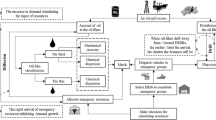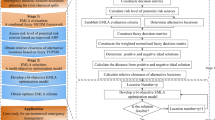Abstract
Aiming to minimize the damage caused by river chemical spills, efficient emergency material allocation is critical for an actual emergency rescue decision-making in a quick response. In this study, an emergency material allocation framework based on time-varying supply-demand constraint is developed to allocate emergency material, minimize the emergency response time, and satisfy the dynamic emergency material requirements in post-accident phases dealing with river chemical spills. In this study, the theoretically critical emergency response time is firstly obtained for the emergency material allocation system to select a series of appropriate emergency material warehouses as potential supportive centers. Then, an enumeration method is applied to identify the practically critical emergency response time, the optimum emergency material allocation and replenishment scheme. Finally, the developed framework is applied to a computational experiment based on south-to-north water transfer project in China. The results illustrate that the proposed methodology is a simple and flexible tool for appropriately allocating emergency material to satisfy time-dynamic demands during emergency decision-making. Therefore, the decision-makers can identify an appropriate emergency material allocation scheme in a balance between time-effective and cost-effective objectives under the different emergency pollution conditions.




Similar content being viewed by others
References
Abounacer R, Rekik M, Renaud J (2014) An exact solution approach for multi-objective location-transportation problem for disaster response. Comput Oper Res 41:83–93
Amini Salehi M, Smith J, Maciejewski AA, Siegel HJ, Chong EKP, Apodaca J, Briceño LD, Renner T, Shestak V, Ladd J, Sutton A, Janovy D, Govindasamy S, Alqudah A, Dewri R, Prakash P (2016) Stochastic-based robust dynamic resource allocation for independent tasks in a heterogeneous computing system. J Parallel Distrib Comput 97:96–111
Barbarosoğlu G, Arda Y (2004) A two-stage stochastic programming framework for transportation planning in disaster response. J Oper Res Soc 55:43–53
Chang M-S, Tseng Y-L, Chen J-W (2007) A scenario planning approach for the flood emergency logistics preparation problem under uncertainty. Transport Res E: Log Transport Rev 43:737–754
Fontem B, Melouk SH, Keskin BB, Bajwa N (2016) A decomposition-based heuristic for stochastic emergency routing problems. Expert Syst Appl 59:47–59
Govindan K (2015) The optimal replenishment policy for time-varying stochastic demand under vendor managed inventory. Eur J Oper Res 242:402–423
Huang Y, Fan Y (2010) Modeling uncertainties in emergency service resource allocation. J Infrastruct Syst 17:35–41
Jiang JP, Wang P, Lung WS, Guo L, Li M (2012) A GIS-based generic real-time risk assessment framework and decision tools for chemical spills in the river basin. J Hazard Mater 227-228:280–291
Khayal D, Pradhananga R, Pokharel S, Mutlu F (2015) A model for planning locations of temporary distribution facilities for emergency response. Socio Econ Plan Sci 52:22–30
Krishna Priya GS, Bandyopadhyay S (2015) Optimum sizing of supply equipment for time varying demand. Comput Chem Eng 83:72–78
Liu J, Guo L, Jiang JP, Jiang DX, Liu RT, Wang P (2016a) A two-stage optimization model for emergency material reserve layout planning under uncertainty in response to environmental accidents. J Hazard Mater 310:30–39
Liu RT, Jiang JP, Guo L, Shi B, Liu J, Du ZL, Wang P (2016b) Screening of pollution control and clean-up materials for river chemical spills using the multiple case-based reasoning method with a difference-driven revision strategy. Environ Sci Pollut Res Int 23:11247–11256
Liu Y, Li Z, Liu J, Patel H (2016c) A double standard model for allocating limited emergency medical service vehicle resources ensuring service reliability. Transport Res C: Emerg Technol 69:120–133
Liu J, Guo L, Jiang JP, Jiang DX, Wang P (2017) Emergency material allocation and scheduling for the application to chemical contingency spills under multiple scenarios. Environ Sci Pollut Res Int 24:956–968
Luscombe R, Kozan E (2016) Dynamic resource allocation to improve emergency department efficiency in real time. Eur J Oper Res 255:593–603
Mohamadi A, Yaghoubi S (2017) A bi-objective stochastic model for emergency medical services network design with backup services for disasters under disruptions: an earthquake case study. Int J Disaster Risk Reduct 23:204–217
Omar M, Sarker R, Othman WAM (2013) A just-in-time three-level integrated manufacturing system for linearly time-varying demand process. Appl Math Model 37:1275–1281
Quinn NWT, Jacobs KC (2007) Design and implementation of an emergency environmental response system to protect migrating salmon in the lower San Joaquin River, California. Environ Model Softw 22:416–422
Sheu J-B (2007) An emergency logistics distribution approach for quick response to urgent relief demand in disasters. Transport Res E: Log Transport Rev 43:687–709
Shi SG, Cao J, Feng L, Liang W, Zhang L (2014) Construction of a technique plan repository and evaluation system based on AHP group decision-making for emergency treatment and disposal in chemical pollution accidents. J Hazard Mater 276:200–206
Su Z, Zhang G, Liu Y, Yue F, Jiang J (2016) Multiple emergency resource allocation for concurrent incidents in natural disasters. Int J Disaster Risk Reduct 17:199–212
Tzeng GH, Cheng HJ, Huang TD (2007) Multi-objective optimal planning for designing relief delivery systems. Transport Res E Log Transport Rev 43:673–686
Wang KJ, Makond B, Liu SY (2011) Location and allocation decisions in a two-echelon supply chain with stochastic demand—a genetic-algorithm based solution. Expert Syst Appl 38:6125–6131
Wex F, Schryen G, Feuerriegel S, Neumann D (2014) Emergency response in natural disaster management: allocation and scheduling of rescue units. Eur J Oper Res 235:697–708
Zhang J-H, Li J, Liu Z-P (2012) Multiple-resource and multiple-depot emergency response problem considering secondary disasters. Expert Syst Appl 39:11066–11071
Zhang C, Liu X, Jiang YP, Fan B, Song X (2016) A two-stage resource allocation model for lifeline systems quick response with vulnerability analysis. Eur J Oper Res 250:855–864
Zhao M, Chen Q (2015) Risk-based optimization of emergency rescue facilities locations for large-scale environmental accidents to improve urban public safety. Nat Hazards 75:163–189
Zhou J, Reniers G (2016) Simulation analysis of the use of emergency resources during the emergency response to a major fire. J Loss Prev Process Ind 44:1–11
Acknowledgements
The authors are extremely grateful to the editors and anonymous reviewers for their insightful comments and suggestions.
Funding
This research was supported by the National Natural Science Foundation of China (71471050) and HIT Environment and Ecology Innovation Special Funds (Grant No. HSCJ201607).
Author information
Authors and Affiliations
Corresponding author
Additional information
Responsible editor: Philippe Garrigues
Rights and permissions
About this article
Cite this article
Liu, J., Guo, L., Jiang, J. et al. Emergency material allocation with time-varying supply-demand based on dynamic optimization method for river chemical spills. Environ Sci Pollut Res 25, 17343–17353 (2018). https://doi.org/10.1007/s11356-018-1489-1
Received:
Accepted:
Published:
Issue Date:
DOI: https://doi.org/10.1007/s11356-018-1489-1




